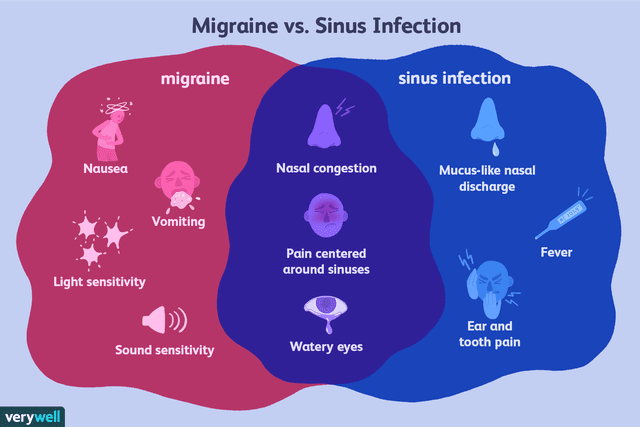The Difference Between Migraine and Sinus Headache
Differentiating the two can help you get the treatment you need
Medically reviewed by Huma Sheikh, MD
Your head is pounding and your face feels as if it's being squeezed in a vise. It seems like every other day or so a sinus headache lays you low. You down a couple of over-the-counter pain pills and try to soldier on, wondering if you should call your healthcare provider for another round of the antibiotics he may have prescribed the last time this happened.
You're right to see your practitioner, but do be prepared to possibly find out that your sinuses aren't to blame for your headaches. There's a very good chance you're having migraines rather than head pain caused by an infection (sinusitis) or by seasonal allergies, all of which share a constellation of similar symptoms.
And if that's the case, you're in good company: The majority of people who believe they have sinus headaches, whether they diagnose themselves or are diagnosed by a healthcare provider, actually have migraines, studies have shown.
Other research has found these patients can go for years without a correct diagnosis or proper treatment, particularly if they've only consulted with a primary care physician or otolaryngology specialist. If you suffer from frequent sinus headaches that don't seem to get better with treatment, talk to your practitioner about the possibility of seeing a headache specialist.

Striking Similarities
When you consider the criteria used to diagnose migraine headaches and those caused by a sinus infection, which can be caused by either virus, bacteria, or seasonal allergies, it's easy to see why the latter often is mistaken for the former.
These symptoms are among those often shared by the two conditions:
Head pain that gets more intense when you lean forward
Facial pressure
It may be obvious, but it's important to note that the type of migraine that's most often mistaken for a sinus headache is migraine without aura—that is, a migraine without any preceding visual or other sensory disturbances.
Related: Sinus Headache Without Congestion: How to Find Relief
Distinguishing Differences
Despite the similarities between sinus headaches and migraines without aura, the two conditions actually have several markedly different symptoms and characteristics. That's why even if you're convinced your headaches are due to a sinus infection or similar ailment, it's a good idea to not write them off as such and attempt to treat yourself.
This is especially important if you're experiencing any of the symptoms in this snapshot of main differences between migraines and sinus headaches:
Migraine
Nausea
Vomiting
Thin, clear nasal discharge
Aversion to strong odors
Sensitivity to light and sounds
Ear or upper tooth pain
Sinus Headache
Fever
Cough
Thick nasal discharge
Decreased sense of smell
Ear or upper tooth pain
Common Migraine Symptoms
Aside from the head pain itself, most people who have frequent migraines also experience an array of other symptoms:
Nausea and/or vomiting: These are so prevalent, anti-emetics (medications for relieving nausea and vomiting) often are a part of treatment for migraine.
Heightened sensory symptoms: A person having a migraine may experience sensitivity to light (photophobia) so extreme that he or she will need to lie down in a dark room. Similarly, during a migraine, otherwise innocuous odors may be perceived as vile, and noises may seem unbearably loud.
Ear or upper tooth pain: Ear and upper tooth pain may affect those suffering from a migraine.
Common Sinus Headache Symptoms
Fever: You won't always run a temperature when you have a headache caused by sinusitis, but it's a distinct possibility, especially if the infection is caused by a bacteria rather than a virus. In that case, an antibiotic actually may be in order to knock out the bacteria.
Purulent nasal discharge: A thick, yellowish or greenish discharge (pus) is a sign of infection.
Ear or upper tooth pain: Ear and upper tooth pain are common complaints in those suffering from a sinus infection.
A Word From Verywell
Armed with a basic understanding of the most common and obvious differences between migraine headache without aura and headaches caused by a sinus infection, you should be able to make an educated guess about which is most likely to be causing your headaches. That said, even if you feel absolutely certain you have sinus headaches rather than migraines, see your healthcare provider for a definitive diagnosis. This way you'll be sure to get the treatment you need as quickly as possible.
Read the original article on Verywell Health.

